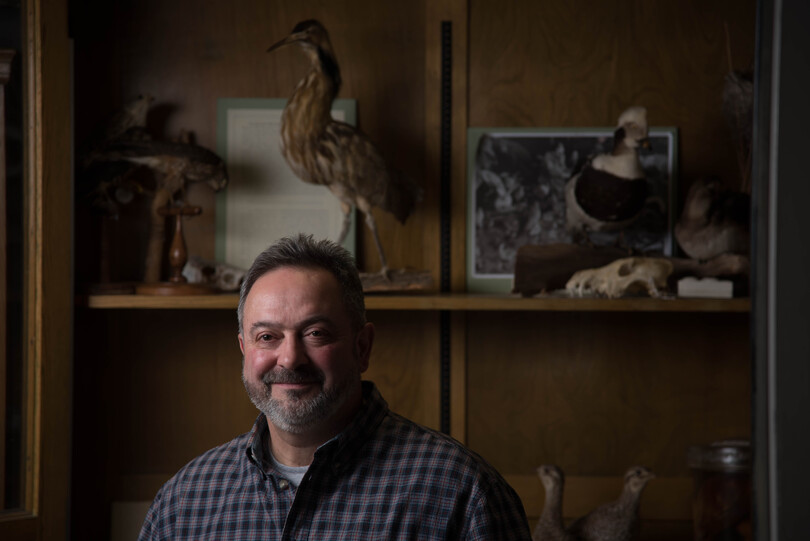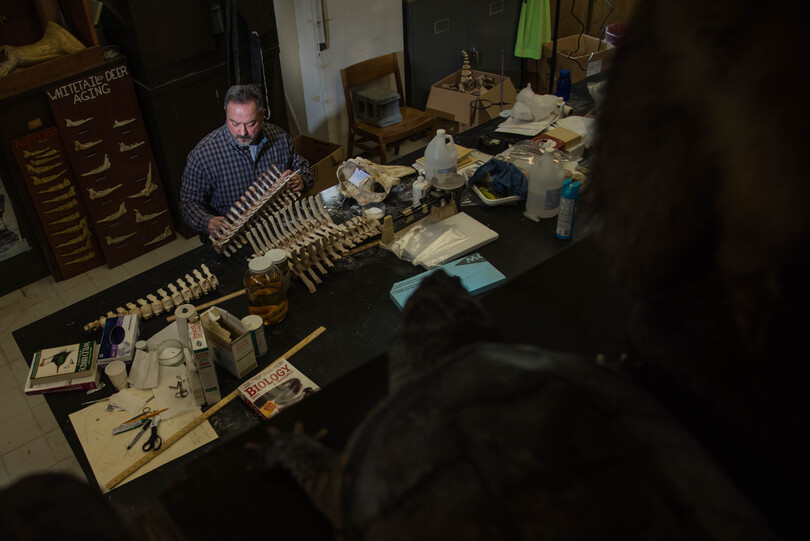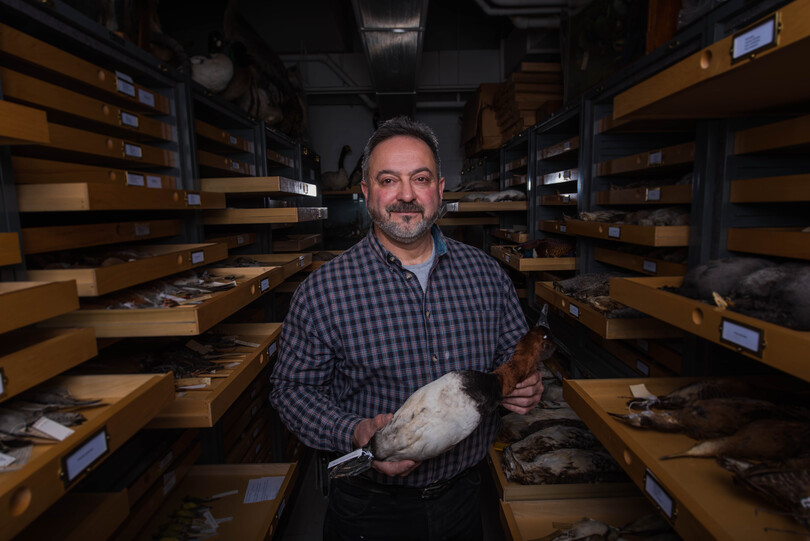SUNY-ESF taxidermist cleans, prepares massive collection of specimens
Ron Giegerich walked through his backyard toward a man-made pond to check on some de-fleshed bones. As he passed by a graveyard with six little marked stones, Giegerich mentally honored his beloved dogs, but continued forward.
Out near the pond, Giegerich looked at the bones. These were not previous pets, but marine mammals’ skeletons being cleaned in the pond. Other specimens’ bones were taken care of by carrion beetles and blow fly larvae. After about six to seven weeks of natural cleaning, these nine marine mammals were ready to come back to the State University of New York College of Environmental Science and Forestry.
As the collections manager for the Roosevelt Wild Life Collections at SUNY-ESF, it’s Giegerich’s job to prepare specimens for display as well as teach a course in vertebrate museum techniques every spring semester. He curates and manages vertebrates in addition to the specimen preparation. In simpler terms, he prepares, manages and handles taxidermy.
Giegerich studied taxidermy in high school and continued the practice in college. From there, he worked for the U.S. Fish and Wildlife Service in the Division of Mammals at the Smithsonian Institution from 1976 to 1977. Giegerich has since been dedicated to working at SUNY-ESF, where he said he enjoys working with students and preparing specimens.
Elyse Iemola, a senior wildlife science major, took his class last year.
“ESF is really cool in that it has a lot of people that are very good at one thing,” Iemola said. “But Ron is really good at everything.”
He’s been busy this past year, cleaning and preparing a total of 15 marine mammals for the collection. He’s never prepared marine mammals before this, but with 39 years of taxidermy work under his belt at SUNY-ESF, Giegerich was ready to take on the challenge.
He cleaned the first five specimens in the preparation room in SUNY-ESF’s Illick Hall until it started to smell, and then decided to use his land back home to finish the job.
Scott Turner, a biology professor and Giegerich’s next-door office neighbor, said Giegerich’s collection is especially important as specimens are often used in other professors’ demonstrations.
“It hasn’t always been supported to the extent that it should be,” Turner said. “He’s always been totally dedicated to this, no matter what the level of financial support is.”
On a day-to-day basis, between specimen identification and preparation, Giegerich is like a normal higher education employee, checking emails and meeting with students, except students will often knock on his door holding a carcass.
With an increase in specimens each year, the collections room in 215 Illick Hall proves to be claustrophobic. The Roosevelt Wild Life Collections contains over 10,000 specimens of birds, mammals, freshwater and marine fishes, reptiles and amphibians.
What helps to keep the collection going is its large number of dead birds — many of which come from flying into power lines or windows. If a specimen cannot be hunted under the protection of the Migratory Bird Treaty Act, finding one dead can often add variety to the collection.
Drawers upon drawers open to reveal several different breeds of birds, with an entire drawer — or three — dedicated to one species. Cabinets keep jarred oddities and smaller reptiles safe and away, while mounted birds stock on each other on the floor of a hall in between more cabinets.
Giegerich hopes to have new museum space in the basement of the Gateway Center for everyone to access by 2017, despite the challenge of moving the entire collection to a new space.
Back home, Giegerich raises pheasants, just as he used to as a child with his father. Joe Folta, a visiting instructor at SUNY-ESF, said Giegerich raises “all kinds of neat-looking birds.” Folta was a student of Giegerich’s about 20 years ago, when Folta obtained his waterfowl identification certificate.
“It’s really helpful that when we come across something that we’re not exactly sure what species or subspecies — he’s the first to contact,” he said.
Iemola, the senior wildlife science major, said when she first met Giegerich, she frantically walked into his office so he could accept her into his class. Instead of asking her to compose herself or to get out, Giegerich calmly asked her what her name was, and they quickly formed a bond.
In her time knowing Giegerich, Iemola said she never felt he was intimidating or arrogant.
“He knows he’s intelligent, but that ability to shove it on you is just not there for him,” Iemola said.
His home life and work life often seam together in one flow, but perhaps with Giegerich’s upbringing, it was always meant to be. As a child, he collected the occasional skull, feather, vertebrate and specimen oddity, but didn’t expect it to one day turn into museum work.
“What started as a hobby became a vocation,” he said.
But even the dirty work doesn’t bother him, because by the end of the day, he’s got his work recorded in the SUNY-ESF Roosevelt Wild Life Collections forever.
“It leaves a legacy behind,” Giegerich said. “There’s a good chance that the specimens I prepared for the university will be around for 100 years, maybe even longer.”
Published on January 26, 2016 at 12:33 am













